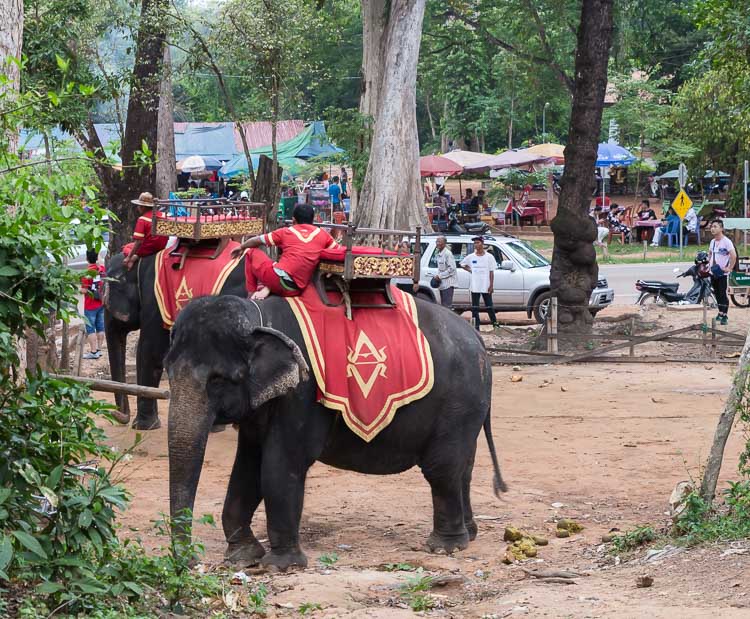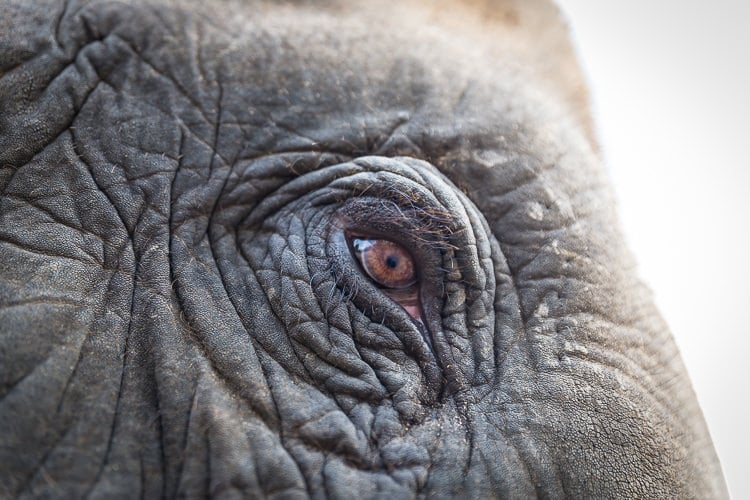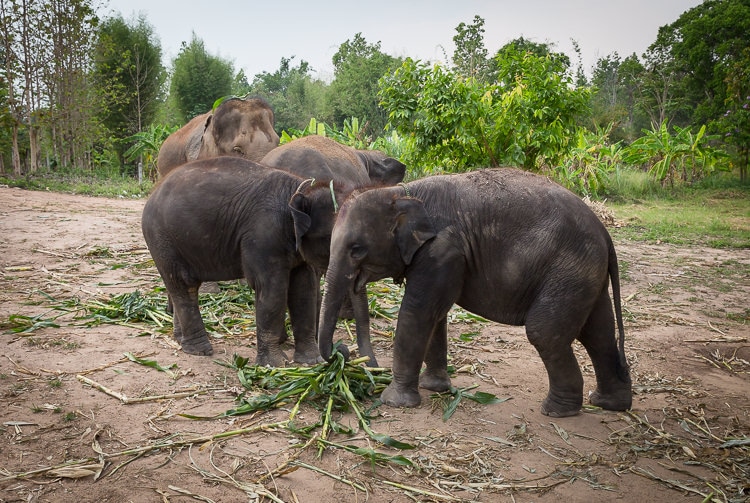Last updated on December 8th, 2023
There’s a misconception that Thailand elephant sanctuaries are an ethical and responsible way to interact with these large, beautiful creatures even without the elephant riding. I thought the same and visited one.
The Elephant Riding Issue

You probably know that elephant riding or multiday trekking is bad for elephants.
If you haven’t, let me break it down for you.
Elephant handlers break elephants physically and mentally for riding at a young age. They beat the elephants with a bullhook to listen to specific riding commands until their spirits break. This is the same way elephants are trained to perform tricks at a circus.
In addition, an elephant’s spine can’t support the weight of humans and a howdah (saddle). I can barely carry my 70-liter backpack for 30 minutes; imagine an elephant carrying a family of tourists.
In Thailand, they still have elephant riding tours. In the Kualanamu airport in Sumatra, Indonesia, there is a big picture of a mahout riding an elephant in the baggage claim area. Elephant riding is still prominent in Southeast Asia.
I personally feel many elephant sanctuaries without riding – and other wildlife sanctuaries for this matter – are not sustainable and are for-profit.
Allow me to explain.
Elephant Sanctuary in Thailand

Originally, I wanted to see elephants in the wild around Chiang Mai, Thailand, because it’s the most natural, ethical, and adventurous way to see them. But I didn’t find any wildlife operators providing this service.
The Doi Inthanon National Park in Chiang Mai province no longer has elephants due to poaching and habitat loss.
But several hotels, hostels, and tour agencies promote elephant sanctuaries in Thailand. The marketing scheme is they state there is no hooking or riding.
I ended up visiting the Maerim Elephant Sanctuary in 2017. In retrospect, I should have traveled to another province in Thailand that had wild elephants in its national park such as the Kui Buri National Park.
There’s a confusing middle ground about sanctuaries.
First, humans aren’t supposed to interact with elephants.
Second, there’s nothing natural about feeding an elephant bananas or washing them in the river. If you tried to do this in the wild, you’d be dead. Plus, it’s harder for elephants to be reintroduced into the wild. You should ask yourself before visiting an elephant sanctuary if the organization releases elephants back into the wild: many do not.

I understand that sanctuaries need to raise money in order to operate. Of course, people will pay to have up-close selfies with an elephant. I did. I regret it now.
Remember that one of the main reasons Asian elephants are endangered and treated cruelly is due to tourism and entertainment such as a circus or elephant riding camp in addition to habitat loss and poaching.
African elephants take most of the damage from the illegal ivory trade due to their bigger tusks. Also, Asian female elephants don’t have tusks whereas the African species do have them.
Volunteering at an Elephant Sanctuary

After my tour visit, I wanted to contribute towards elephant conservation but also now to get a better understanding of the elephant sanctuary model in Thailand.
I was skeptical, but I volunteered at the Maerim Elephant Sanctuary as a tour guide for 5 weeks.
I had the chance to see what most tourists don’t see at an elephant sanctuary. Reading Tripadvisor reviews from guests or volunteers that are happy-go-lucky to be around elephants just doesn’t cut it. I’m trying to be objective.
For the most part, my time volunteering was great. I made some great friends and the family that operated the facility treated me well. I was fortunate to be around elephants and observe their behaviors. The only real hard part was watching for the safety of the guests. Nobody was hurt on my watch.
From what I was told, the elephants at the Maerim Elephant Sanctuary were bought from their abusers at $40,000 each. You can also rent elephants in Thailand.
The mahouts (elephant keepers) treated the elephants really well from what I saw. From the way the mahouts bathed them in the river to how they showed their affection for the elephants. What happened at night when I was away I can’t speak for. This is true for any other sanctuary.
It was one mahout for each elephant. Some elephant sanctuaries have one mahout for multiple elephants which decreases the bond between a mahout and an elephant.
The sanctuary also covered the medical costs of the elephants.
Towards the end of my volunteer placement at the elephant sanctuary, I did see one of the mahouts slap his elephant due to not coming over to the guests to eat bananas. The elephant clearly wasn’t pleased.
The elephants don’t need to follow the tour schedule. This was also what we told our guests that the tour can change depending on the elephant. I had no problem if the elephants didn’t want to eat or go on a walk (even though they need it for exercise). I don’t think the guests minded either.
One time I saw an elephant tied up by one foot to a pole.
In both of these instances, I told the owner of the sanctuary so she can prevent this type of treatment. She does speak to the mahouts about handling the elephants with care. Maybe these instances are one-offs, and they’re not too bad. You be the judge.

Most of the visitors to the sanctuary were ecstatic about the experience. I’ve had a few visitors disagree about commanding an elephant to wave bye with her trunk. Just remember how elephants learn tricks. I guess one can argue these tricks are for a good cause now.
Another visitor only paid half the tour price in order to only see the elephants and nothing more. No feeding, touching or bathing them. This was the more responsible way to see the elephants at a sanctuary.
Even with these instances, the Maerim Elephant Sanctuary is still comparable with the better sanctuaries. Originally, I wrote this post several months prior before publishing it. I didn’t want to be vindictive, but I think my opinion on elephant sanctuaries and conservation is of value.
It’s not fair that I don’t have a report on other sanctuaries, especially when I don’t find several other objective reviews of elephant sanctuaries from an employee or volunteer perspective. If you were planning to visit the Maerim Elephant Sanctuary, then still go.
Anyways, these seem like small issues at an elephant sanctuary, but it gets people thinking.
From what I was told by a Thai tour guide I worked with, some of the older mahouts that work at elephant sanctuaries were the same people that were cruel to elephants at a circus or elephant riding camp. This part I kind of already guessed. At least these mahouts are better at treating the elephants now. Call it a win.
I don’t condone cruelty toward animals, but I somewhat understand a mahout’s cruel treatment towards an elephant: lack of education and lack of jobs. And many people think we rule over all living things. But progress is made with awareness and how tourists spend their money.
The important outcome of cruel mahouts is that they realize it’s wrong and they stop the mistreatment. This applies to all elephant sanctuaries. Elephant sanctuary owners, employees, and guests are responsible for the ethical treatment of elephants, especially in Southeast Asia.
Volunteering with elephant sanctuaries is not the only issue. It can also apply to any type of wildlife sanctuary or refuge such as volunteering with lion cubs in South Africa.
Animal Selfies
A stickier problem is tourists taking selfies with elephants. I sure did when I first went on the tour.

When these photos of (previously) mistreated elephants are shared on social media, it causes a snowball effect of more people wanting to visit elephant sanctuaries for the sole purpose of human gain and not the rehabilitation of elephants. Tourists that normally wouldn’t visit an elephant sanctuary may now unknowingly visit an unethical one.
Sometimes it’s people that love animals that hurt them the most.
Instagram is also against animal selfies. You can read more about it here.
I’m going to prevent my photos of rescued elephants from seeing the light of day. It’ll be a reminder of how I screwed up. However, I do post images of elephants without me in the photo for awareness or editorial reasons.
I’m all for owners and the local community earning a salary by operating an elephant sanctuary. What I’m not for are elephant sanctuary owners operating a sanctuary like a for-profit, for-personal-gain business at the expense of abused elephants: it’s not ethical.
How do I know some of these elephant sanctuaries are for-profit? Well, I can’t go into it in detail here but let’s just say some things didn’t add up while I was in Thailand for 2 months plus other parts of Southeast Asia.
10 years ago elephant riding was acceptable and major tour operators like G Adventures offered elephant riding in Thailand as part of the tour package. Now the major tour operators have removed elephant riding from their travel packages.
Many companies, including the travel insurance company, World Nomads, wrote about why elephant riding should be stopped.
Now I think it’s time for major players to shed more light on elephant sanctuaries and make these places more transparent. There’s still a long way to go.
I’m not here to tell you what to do or not to visit wildlife sanctuaries. I believe some sanctuaries are legit which I’ll still visit: such as the Jaguar Rescue Center in Costa Rica. But be well-informed about which one you visit.
And for those selfies with elephants, tigers, and koalas in wildlife sanctuaries, if you still want to do it, then go for it. But it’s more sustainable to get these types of photos in the wild even if you can’t get as close which is something I try to do.
What do you think about taking selfies with endangered animals at a sanctuary and then posting them online?


I love this. It got me thinking in ways I needed to prior to visiting elephants. Thanks for sharing!